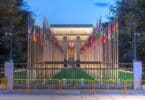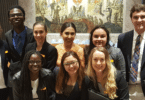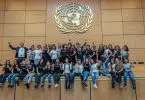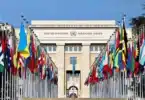Small neighborhoods and sprawling cities, quiet museums and loud stadiums, new hospitals and old libraries – these are all examples of architecture. We’re surrounded by architecture, so it’s very easy to not realize how big a role it plays in our daily lives. These spaces aren’t neutral, however. In the United States, there’s a long history of anti-Blackness baked into the country’s physical design. In the online course “Reimagining Blackness and Architecture,” students will learn what “spatial inequality” looks like, imagine new spaces, and hear the voices of Black architects that have been ignored.
How does American architecture uphold white supremacy?
Before we talk about the course, why is it so important in the first place? How does systemic racism manifest in the country’s landscape? In 2021, MoMA asked that question with its exhibition: “Reconstructions: Architecture and Blackness in America.” There were ten artists featured. Sekou Cooke described how spaces designed for Black people have always reflected the disdain the country has for Blackness. That includes Southern slave quarters and farm settlements to Northern ghettos and slums. These spaces, as well as public housing projects, have a reputation for being what Cooke calls “leftover, disposable, and characterless environments.”
Segregation with its separate water fountains, segregated schools, and white-only stores is another prime example of America using architecture to oppress. Today, high-poverty school districts that primarily serve students of color receive fewer funds because school funding systems depend on geography. These schools are essentially punished for existing in poor communities. White supremacy in architecture also manifests in how Black architects are less recognized in society. Pretty much everyone has heard of Frank Lloyd Wright, but what about Paul Revere William, who designed homes for celebrities like Lucille Ball and Frank Sinatra? Today, Black architects still struggle to get the industry to acknowledge racism.
What you can expect in “Reimagining Blackness and Architecture”
Instructors Arlette Hernandez (Volkswagen Fellow for Digital Learning) and Sean Anderson (Associate Curator with the Department of Architecture & Design) lead students through this 6-week course. You’ll hear from Black architects, writers, scholars, and artists through videos, audio interviews, and readings. The course consists of an introduction week and five themed weeks: Imagination, Care, Knowledge, Refusal, and Liberation.
Week 1: Intro
This week introduces the course with videos, readings, and a quiz. Key terms are explored, as well as ground rules for engagement and optional prompts for discussion and reflection. Videos include Charles Davis on the expansive field of architecture and Adrienne Brown on the Reconstruction era. Students are also introduced to the Black Reconstruction Collective, a group of artists that asks how architecture can be a tool for liberation, joy, and Black futures.
Week 2: Imagination
This week dives into questions like what is Blackness, as well as new ways of seeing. Readings include Walter Hood (an architect) on his project “Black Towers / Black Power” and advice for emerging architects and creatives.
Week 3: Care
Material for this week focuses on readings from artist Sekou Cooke and architect and artist J. Yolande Daniels, as well as various videos. Students also learn about “the tender lenses of two photographers” and how artists repurpose and salvage different materials and objects.
Week 4: Knowledge
This week includes Amanda Williams’ project “We’re Down There, We’re Over Here,” a 2020 MoMa piece that includes materials like ice cream scoopers and aluminum scaffold, as well as Olalekan Jeyifous’ piece “The Frozen Neighborhoods,” which imagines speculative future transformed by climate change. Other topics include “the magic of stories” and “artifacts for the future.”
Week 5: Refusal
Students are introduced to photographer Robert McNeill, who released a series called “The Bronx Slave Market.” Taken in the autumn of 1937, this series follows workers who stood at a street corner waiting for jobs and their prospective employers. Other videos include V. Mitch McEwen on Philip Johnson, Architecture, and White Supremacy. Topics for discussion include artists creating their own stories, striking their own paths, and refusing expectations.
Week 6: Liberation
In this final week, students hear from engineer/architect Felecia Davis on “Fabricating Networks: Transmissions and Receptions from Pittsburgh’s Hill District,” as well as cultural practice architect Mario Gooden on “The Refusal of Space.” Searching for freedom, the power of printmaking, and optional readings are also included.
Goals of the course
By the end of the course, students will see how race and racism have shaped architecture, as well as how Black architects and creators have reimagined the built environment of our world. Inspired by how architects have made their own way and dreamed big, students will understand how they can play a part in building an equitable world. The entire course takes about 14 hours to complete and is meant for beginners. You don’t need any previous knowledge of architecture, art, or history to successfully complete the course. Deadlines are flexible.












